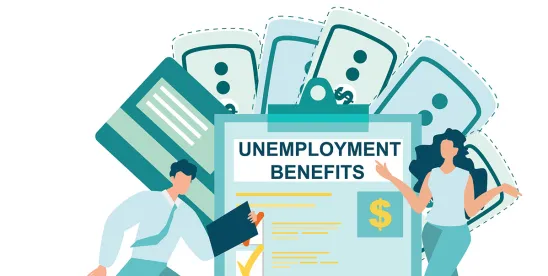The U.S. Department of Labor (DOL) recently issued an update to its Unemployment Insurance Program Letter (UIPL) 16-20 to provide additional guidance on the CARES Act’s Pandemic Unemployment Assistance (PUA) program in response to questions submitted by states.
As a quick refresher, PUA expands unemployment benefit coverage to certain workers who traditionally are not eligible for benefits under state law, such as individuals who are self-employed, are independent contractors or gig economy workers, or have limited work history, among others. These individuals may be eligible for PUA if they are unemployed, partially unemployed, or unable to work for certain reasons relating to COVID-19, including, but not limited to: (i) being diagnosed with COVID-19; (ii) caring for a family or household member diagnosed with COVID-19; (iii) caring for a child or household member whose school is closed due to COVID-19; (iv) being unable to reach their place of employment due to an imposed quarantine; or (v) being unable to report to their place of employment because it has been closed as a direct result of COVID-19. For more information about the PUA program and eligibility criteria, as well as information about the supplemental $600 weekly benefit and the extended 13 weeks of unemployment benefits set forth in other provisions of the CARES Act, see our previous blog posts: CARES Act Expands Unemployment Insurance Benefits and U.S. DOL Issues Additional Guidance on CARES Act Unemployment Programs.
The federal DOL’s update responds to 57 state-submitted questions about PUA program administration and also provides guidance to states on calculating the weekly benefit amount for PUA claimants. The following is a summary of the notable new information.
Claims Filing
Are states required to review claims that were denied for regular unemployment compensation to assess eligibility for PUA?
Yes. States are required to review regular unemployment claims that were denied from January 27, 2020 to the present, and identify individuals who are potentially eligible for PUA. States then must notify those individuals in writing of their potential eligibility, as well as provide filing instructions.
Are states required to have a separate application for PUA claims?
No. As long as states are able to discern those who are filing under the PUA program from those filing for regular unemployment benefits, they are not required to have a separate application for PUA benefits (but some states nevertheless may elect to have separate applications).
Eligibility
How can states determine that claimants are unemployed, partially unemployed, or unable to work due to one of the qualifying reasons related to COVID-19 set forth in the CARES Act?
States must require claimants to complete a self-certification identifying the qualifying COVID-19 related eligibility criteria under which they are seeking PUA benefits. Claimants must acknowledge that the certification is made under penalty of perjury.
If an individual refuses to return to work because they prefer to receive unemployment benefits, are they eligible for PUA?
No. Individuals are not eligible for PUA if they refuse to work when called back by an employer because they want to receive unemployment benefits instead.
If an individual refuses to work because of a general concern of exposure to COVID-19, are they eligible for PUA?
No. Individuals are not eligible if they refuse to work because of a general fear of exposure. However, individuals who are advised by a health care provider to self-quarantine due to concerns related to COVID-19 may be eligible for PUA benefits.
If an individual is on approved unpaid medical leave from an employer and is not able/available to work, are they eligible for PUA?
It depends. If the unpaid medical leave is due to one of the qualifying COVID-19 related reasons set forth in the CARES Act, then the individual may be eligible for PUA. If the individual does not satisfy the COVID-19 related eligibility criteria, they are not eligible for PUA.
For the PUA eligibility criteria that require a medical diagnosis (e.g., the individual has COVID-19, the individual is caring for a family member with COVID-19), is a positive test required?
No. While a positive test is certainly sufficient to qualify for PUA, any diagnosis from a qualified medical professional, including one made via phone or telehealth, is also sufficient.
If an individual qualifies for PUA because they are caring for a child whose school is closed due to COVID-19, are they still eligible during summer months?
No. After the 2019-2020 school year was originally scheduled to end, a school is no longer considered to be closed as a direct result of the COVID-19 health emergency. However, if the facility that the individual relies on to provide summer child care is also closed as a direct result of COVID-19, then they may still qualify for PUA.
Is an individual required to search for work while collecting PUA benefits?
Any applicable state laws relating to continuing claims for regular unemployment benefits apply to PUA claims. However, states may use the emergency flexibility to temporarily modify or suspend work search requirements as needed in response to COVID-19. Many states have already done so, and claimants and employers should consult applicable state websites for guidance.
Calculating the PUA Weekly Benefit Amount
The DOL’s update also includes guidance about how states should calculate an individual’s PUA weekly benefit amount (“WBA”). As a general rule, the PUA WBA is calculated using the same formula as the applicable state’s regular unemployment program. This is done by taking an individual’s wages over an established “base period” and applying a formula that varies from state-to-state. For PUA purposes, the “base period” is calendar year 2019. An individual’s PUA WBA may not be higher than the applicable state maximum WBA for regular unemployment benefits. For weeks of unemployment beginning on or after April 5, 2020 and ending on or before July 31, 2020, PUA recipients also are entitled to an extra $600 per week in Federal Pandemic Unemployment Compensation benefits in addition to the PUA WBA.
If an eligible individual has insufficient wages or net income (or no wages or income) in the base period to compute a WBA, the individual is entitled to receive the minimum PUA WBA. The minimum PUA WBA varies by state, but is calculated as “50 percent of the average weekly payment of regular compensation in the state” as published by the DOL. Specifically, the DOL directed states to use the amounts set forth in UIPL 03-20 for calculating the minimum WBA on all PUA claims.
It is important to remember that PUA is federally funded, but administered by the states. Therefore, there may be variations in how each state implements its program. Employers and claimants should monitor websites for any applicable state unemployment insurance program updates.
Visit our Coronavirus Resource Center for guidance on risk management measures, practical steps businesses can take and resources to help manage ongoing operations.





 />i
/>i

